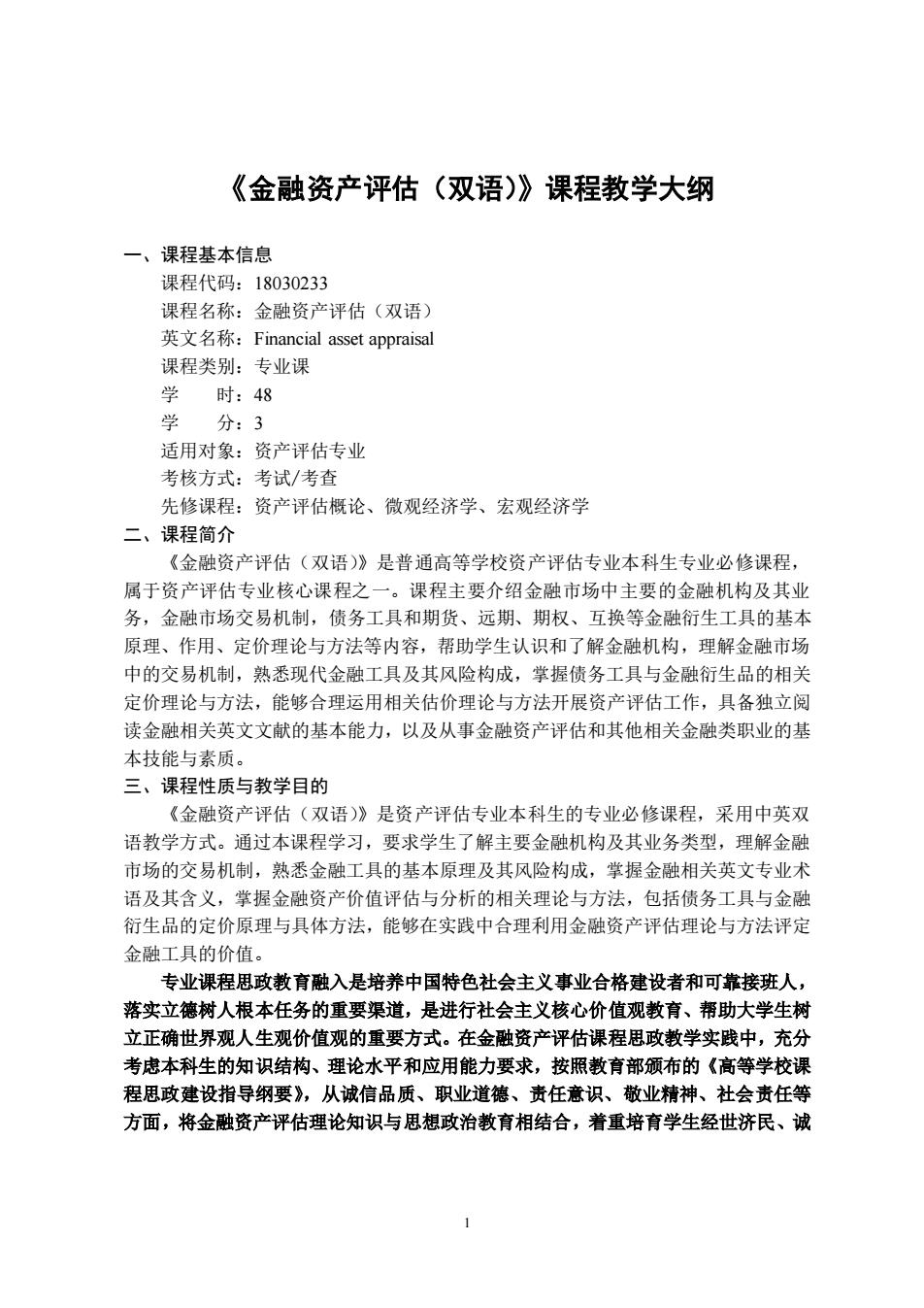
《金融资产评估(双语)》课程教学大纲 一、课程基本信息 课程代码:18030233 课程名称:金融资产评估(双语) 英文名称:Financial asset appraisal 课程类别:专业课 时:48 学分:3 适用对象:资产评估专业 考核方式:考试/考查 先修课程:资产评估概论、微观经济学、宏观经济学 二、课程简介 《金融资产评估(双语)》是普通高等学校资产评估专业本科生专业必修课程, 属于资产评估专业核心课程之一。课程主要介绍金融市场中主要的金融机构及其业 务,金融市场交易机制,债务工具和期货、远期、期权、互换等金融衍生工具的基本 原理、作用、定价理论与方法等内容,帮助学生认识和了解金融机构,理解金融市场 中的交易机制,熟悉现代金融工具及其风险构成,掌握债务工具与金融衍生品的相关 定价理论与方法,能够合理运用相关估价理论与方法开展资产评估工作,具备独立阅 读金融相关英文文献的基本能力,以及从事金融资产评估和其他相关金融类职业的基 本技能与素质。 三、课程性质与教学目的 《金融资产评估(双语)》是资产评估专业本科生的专业必修课程,采用中英双 语教学方式。通过本课程学习,要求学生了解主要金融机构及其业务类型,理解金融 市场的交易机制,熟悉金融工具的基本原理及其风险构成,学握金融相关英文专业术 语及其含义,掌握金融资产价值评估与分析的相关理论与方法,包括债务工具与金融 衍生品的定价原理与具体方法,能够在实践中合理利用金融资产评估理论与方法评定 金融工具的价值。 专业课程思政教育融入是培养中国特色社会主义事业合格建设者和可靠接班人, 落实立德树人根本任务的重要渠道,是进行社会主义核心价值观教育、帮助大学生树 立正确世界观人生观价值观的重要方式。在金融资产评估课程思政教学实践中,充分 考虑本科生的知识结构、理论水平和应用能力要求,按照教育部颁布的《高等学校课 程思政建设指导纲要》,从诚信品质、职业道德、责任意识、敬业精神、社会责任等 方面,将金融资产评估理论知识与思想政治教育相结合,着重培育学生经世济民、诚
1 《金融资产评估(双语)》课程教学大纲 一、课程基本信息 课程代码:18030233 课程名称:金融资产评估(双语) 英文名称:Financial asset appraisal 课程类别:专业课 学 时:48 学 分:3 适用对象:资产评估专业 考核方式:考试/考查 先修课程:资产评估概论、微观经济学、宏观经济学 二、课程简介 《金融资产评估(双语)》是普通高等学校资产评估专业本科生专业必修课程, 属于资产评估专业核心课程之一。课程主要介绍金融市场中主要的金融机构及其业 务,金融市场交易机制,债务工具和期货、远期、期权、互换等金融衍生工具的基本 原理、作用、定价理论与方法等内容,帮助学生认识和了解金融机构,理解金融市场 中的交易机制,熟悉现代金融工具及其风险构成,掌握债务工具与金融衍生品的相关 定价理论与方法,能够合理运用相关估价理论与方法开展资产评估工作,具备独立阅 读金融相关英文文献的基本能力,以及从事金融资产评估和其他相关金融类职业的基 本技能与素质。 三、课程性质与教学目的 《金融资产评估(双语)》是资产评估专业本科生的专业必修课程,采用中英双 语教学方式。通过本课程学习,要求学生了解主要金融机构及其业务类型,理解金融 市场的交易机制,熟悉金融工具的基本原理及其风险构成,掌握金融相关英文专业术 语及其含义,掌握金融资产价值评估与分析的相关理论与方法,包括债务工具与金融 衍生品的定价原理与具体方法,能够在实践中合理利用金融资产评估理论与方法评定 金融工具的价值。 专业课程思政教育融入是培养中国特色社会主义事业合格建设者和可靠接班人, 落实立德树人根本任务的重要渠道,是进行社会主义核心价值观教育、帮助大学生树 立正确世界观人生观价值观的重要方式。在金融资产评估课程思政教学实践中,充分 考虑本科生的知识结构、理论水平和应用能力要求,按照教育部颁布的《高等学校课 程思政建设指导纲要》,从诚信品质、职业道德、责任意识、敬业精神、社会责任等 方面,将金融资产评估理论知识与思想政治教育相结合,着重培育学生经世济民、诚
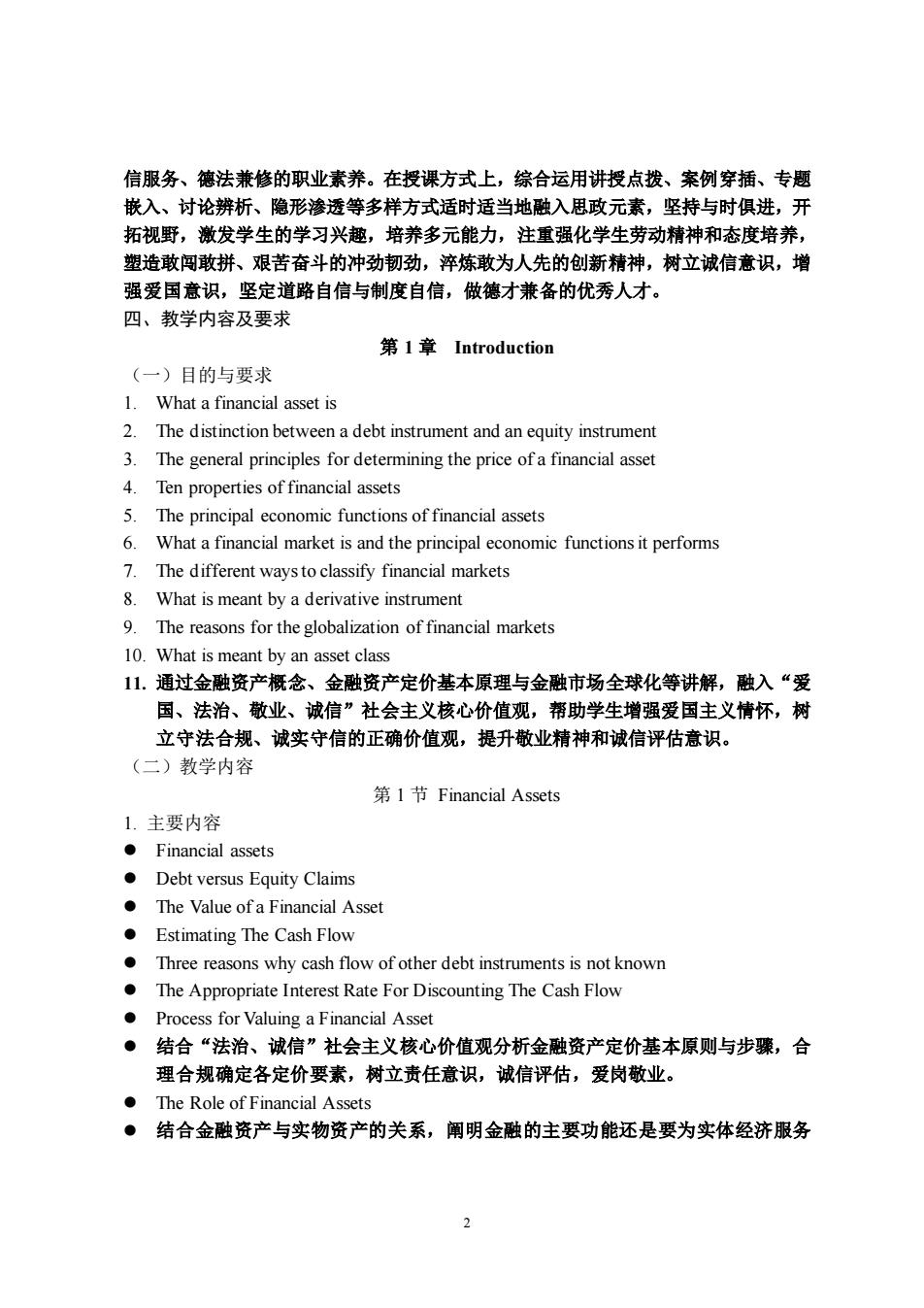
信服务、德法兼修的职业素养。在授课方式上,综合运用讲授点拨、案例穿插、专题 嵌入、讨论辨析、隐形渗透等多样方式适时适当地融入思政元素,坚持与时俱进,开 拓视野,激发学生的学习兴趣,培养多元能力,注重强化学生劳动精神和态度培养, 塑造敢闯敢拼、艰苦奋斗的冲劲韧劲,淬炼敢为人先的创新精神,树立诫信意识,增 强爱国意识,坚定道路自信与制度自信,做德才兼备的优秀人才。 四、教学内容及要求 第1章Introduction (一)目的与要求 1.What a financial asset is 2.The distinction between a debt instrument and an equity instrument 3.The general principles for determining the price ofa financial asset 4.Ten properties of financial assets 5.The principal economic functions of financial assets 6. What a financial market is and the principal economic functions it performs 7.The different waysto classify financial markets 8.What is meant by a derivative instrument 9.The reasons for the globalization of financial markets 10 What is meant by an asset class 11.通过金融资产概念、金融资产定价基本原理与金融市场全球化等讲解,融入“爱 国、法治、敬业、诚信”社会主义核心价值观,帮助学生增强爱国主义情怀,树 立守法合规、诚实守信的正确价值观,提升敬业精神和诚信评估意识。 (二)教学内容 第1节Financial Assets 1.主要内容 ●Financial assets o Debt versus Equity Claims The Value ofa Financial Asset Estimating The Cash Flow .Three reasons why cash flow of other debt instruments is not known The Appropriate Interest Rate For Discounting The Cash Flow Process for Valuing a Financial Asset ·结合“法治、诚信”社会主义核心价值观分析金融资产定价基本原则与步骤,合 理合规确定各定价要素,树立责任意识,诚信评估,爱岗敬业。 o The role of financial assets ·结合金融资产与实物资产的关系,阐明金融的主要功能还是要为实体经济服务
2 信服务、德法兼修的职业素养。在授课方式上,综合运用讲授点拨、案例穿插、专题 嵌入、讨论辨析、隐形渗透等多样方式适时适当地融入思政元素,坚持与时俱进,开 拓视野,激发学生的学习兴趣,培养多元能力,注重强化学生劳动精神和态度培养, 塑造敢闯敢拼、艰苦奋斗的冲劲韧劲,淬炼敢为人先的创新精神,树立诚信意识,增 强爱国意识,坚定道路自信与制度自信,做德才兼备的优秀人才。 四、教学内容及要求 第 1 章 Introduction (一)目的与要求 1. What a financial asset is 2. The distinction between a debt instrument and an equity instrument 3. The general principles for determining the price of a financial asset 4. Ten properties of financial assets 5. The principal economic functions of financial assets 6. What a financial market is and the principal economic functions it performs 7. The different ways to classify financial markets 8. What is meant by a derivative instrument 9. The reasons for the globalization of financial markets 10. What is meant by an asset class 11. 通过金融资产概念、金融资产定价基本原理与金融市场全球化等讲解,融入“爱 国、法治、敬业、诚信”社会主义核心价值观,帮助学生增强爱国主义情怀,树 立守法合规、诚实守信的正确价值观,提升敬业精神和诚信评估意识。 (二)教学内容 第 1 节 Financial Assets 1. 主要内容 ⚫ Financial assets ⚫ Debt versus Equity Claims ⚫ The Value of a Financial Asset ⚫ Estimating The Cash Flow ⚫ Three reasons why cash flow of other debt instruments is not known ⚫ The Appropriate Interest Rate For Discounting The Cash Flow ⚫ Process for Valuing a Financial Asset ⚫ 结合“法治、诚信”社会主义核心价值观分析金融资产定价基本原则与步骤,合 理合规确定各定价要素,树立责任意识,诚信评估,爱岗敬业。 ⚫ The Role of Financial Assets ⚫ 结合金融资产与实物资产的关系,阐明金融的主要功能还是要为实体经济服务
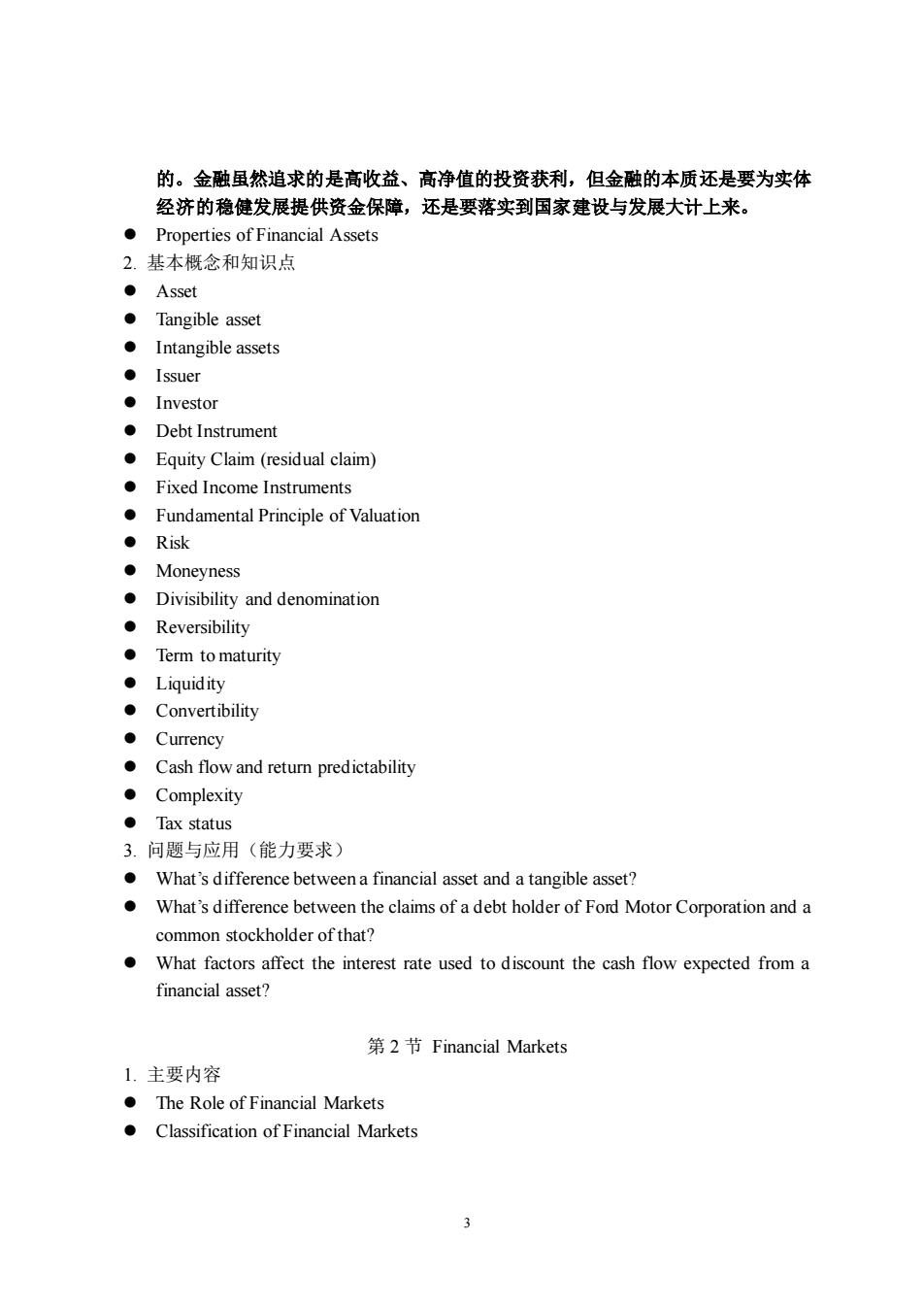
的。金融虽然追求的是高收益、高净值的投资获利,但金融的本质还是要为实体 经济的稳健发展提供资金保障,还是要落实到国家建设与发展大计上来。 Properties of Financial Assets 2.基本概念和知识点 ●Asset ·Tangible asset ●Intangible assets ●Issuer ●Investor ●Debt Instrument Equity Claim(residual claim) o Fixed Income Instruments Fundamental Principle of Valuation ●Risk ·Moneyness Divisibility and denomination ●Reversibility ●Term to maturit Liquidity ●Convertibility ●Currency o Cash flow and return predictability ●Complexity ●Tax status 3.问题与应用(能力要求) What's difference between a financial asset and a tangible asset? What's difference between the claims of a debt holder of Ford Motor Corporation and a common stockholder of that? What factors affect the interest rate used to discount the cash flow expected from a financial asset? 第2节Financial Markets 1.主要内容 The Role of Financial Markets Classification of Financial Markets 3
3 的。金融虽然追求的是高收益、高净值的投资获利,但金融的本质还是要为实体 经济的稳健发展提供资金保障,还是要落实到国家建设与发展大计上来。 ⚫ Properties of Financial Assets 2. 基本概念和知识点 ⚫ Asset ⚫ Tangible asset ⚫ Intangible assets ⚫ Issuer ⚫ Investor ⚫ Debt Instrument ⚫ Equity Claim (residual claim) ⚫ Fixed Income Instruments ⚫ Fundamental Principle of Valuation ⚫ Risk ⚫ Moneyness ⚫ Divisibility and denomination ⚫ Reversibility ⚫ Term to maturity ⚫ Liquidity ⚫ Convertibility ⚫ Currency ⚫ Cash flow and return predictability ⚫ Complexity ⚫ Tax status 3. 问题与应用(能力要求) ⚫ What’s difference between a financial asset and a tangible asset? ⚫ What’s difference between the claims of a debt holder of Ford Motor Corporation and a common stockholder of that? ⚫ What factors affect the interest rate used to discount the cash flow expected from a financial asset? 第 2 节 Financial Markets 1. 主要内容 ⚫ The Role of Financial Markets ⚫ Classification of Financial Markets
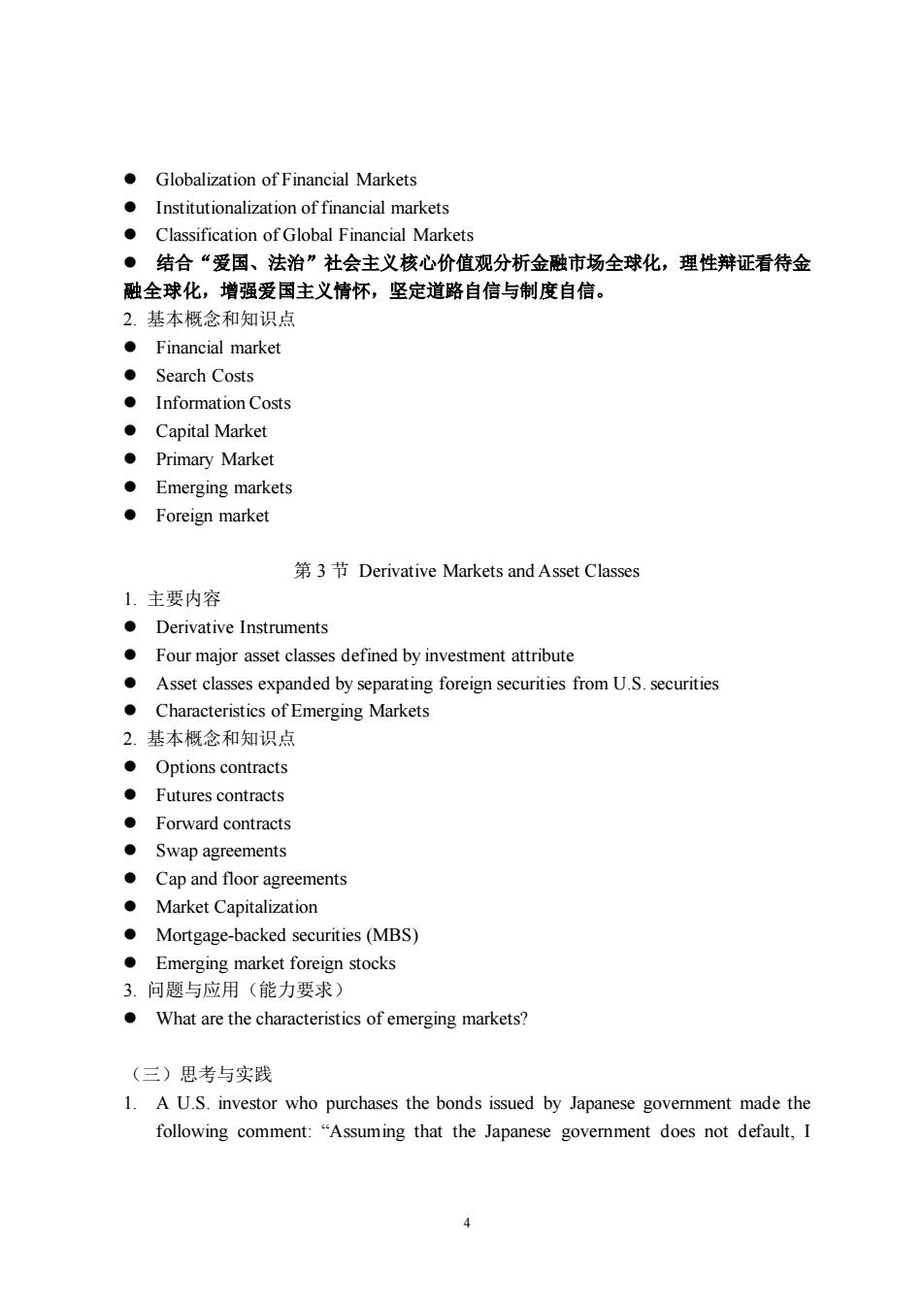
Globalization of Financial Markets Institutionalization of financial markets Classification of Global Financial Markets ·结合“爱国、法治”社会主义核心价值观分析金融市场全球化,理性辩证看待金 融全球化,增强爱国主义情怀,坚定道路自信与制度自信。 2.基本概念和知识点 ●Financial market ●Search Costs ●Information Costs ●Capital Market ●Primary Market ●Emerging markets ●Foreign market 第3节Derivative Markets and Asset Classes 1.主要内容 Derivative Instruments Four major asset classes defined by investment attribute Asset classes expanded by separating foreign securities from U.S.securitie Characteristics of Emerging Markets 2.基本概念和知识点 ●Options contracts ●Futures contracts ●Forward contracts o Cap and floor agreements Market Capitalization Mortgage-backed securities(MBS) Emerging market foreign stocks 3.问题与应用(能力要求) What are the characteristics of emerging markets? (三)思考与实践 1.A U.S.investor who purchases the bonds issued by Japanese govemment made the following comment:"Assuming that the Japanese government does not default,I 4
4 ⚫ Globalization of Financial Markets ⚫ Institutionalization of financial markets ⚫ Classification of Global Financial Markets ⚫ 结合“爱国、法治”社会主义核心价值观分析金融市场全球化,理性辩证看待金 融全球化,增强爱国主义情怀,坚定道路自信与制度自信。 2. 基本概念和知识点 ⚫ Financial market ⚫ Search Costs ⚫ Information Costs ⚫ Capital Market ⚫ Primary Market ⚫ Emerging markets ⚫ Foreign market 第 3 节 Derivative Markets and Asset Classes 1. 主要内容 ⚫ Derivative Instruments ⚫ Four major asset classes defined by investment attribute ⚫ Asset classes expanded by separating foreign securities from U.S. securities ⚫ Characteristics of Emerging Markets 2. 基本概念和知识点 ⚫ Options contracts ⚫ Futures contracts ⚫ Forward contracts ⚫ Swap agreements ⚫ Cap and floor agreements ⚫ Market Capitalization ⚫ Mortgage-backed securities (MBS) ⚫ Emerging market foreign stocks 3. 问题与应用(能力要求) ⚫ What are the characteristics of emerging markets? (三)思考与实践 1. A U.S. investor who purchases the bonds issued by Japanese government made the following comment: “Assuming that the Japanese government does not default, I

known that the cash flow of the bond will be."Explain why you agree or disagree that? 2.Why liquidity may depend not only on the type of financial asset but also on the quantity one wishes to sell or buy? (四)教学方法与手段 本章主要采用课堂讲授、多媒体教学和课堂讨论的教学方法和手段 2 Overview of Market Participants and Financial Innovation (一)目的与要求 1.Participants in financial markets 2.Business of financial institutions 3.What a financial intermediary is 4.How do financial intermediaries provide at least one of four economic functions 5.The nature of the management of assets and liabilities by financial intermediaries 6.How different financial institutions use differing degrees of knowledge and certainty about the amount and timing of the cash outlay of their liabilities 7.The typical justification for govemmental regulation of markets 8.How the government regulates financial markets 9.What is meant by financial innovation and the causes of financial innovation 10.What securitization i 11.通过证券化原理的讲解,融入“自由、公正、法治、爱国”社会主义核心价值观, 启发学生“道路自信”、“制度自信”,增强学生爱国主义情怀。 (二)教学内容 第节The Players&Financial Institutions 1.主要内容 Who're the Players in financial markets Financial institutions provide a variety of services Role of Financial Intermediaries Asset/Liability Management for Financial Institutions 2.基本概念和知识点 Nonfinancial Corporations Depository Institutions Asset Management Firms ●Investment Banks Financial institutions Financial intermediaries
5 known that the cash flow of the bond will be.” Explain why you agree or disagree that? 2. Why liquidity may depend not only on the type of financial asset but also on the quantity one wishes to sell or buy? (四)教学方法与手段 本章主要采用课堂讲授、多媒体教学和课堂讨论的教学方法和手段。 第 2 章 Overview of Market Participants and Financial Innovation (一)目的与要求 1. Participants in financial markets 2. Business of financial institutions 3. What a financial intermediary is 4. How do financial intermediaries provide at least one of four economic functions 5. The nature of the management of assets and liabilities by financial intermediaries 6. How different financial institutions use differing degrees of knowledge and certainty about the amount and timing of the cash outlay of their liabilities 7. The typical justification for governmental regulation of markets 8. How the government regulates financial markets 9. What is meant by financial innovation and the causes of financial innovation 10. What securitization is 11. 通过证券化原理的讲解,融入“自由、公正、法治、爱国”社会主义核心价值观, 启发学生“道路自信”、“制度自信”,增强学生爱国主义情怀。 (二)教学内容 第 1 节 The Players & Financial Institutions 1. 主要内容 ⚫ Who’re the Players in financial markets ⚫ Financial institutions provide a variety of services ⚫ Role of Financial Intermediaries ⚫ Asset/Liability Management for Financial Institutions 2. 基本概念和知识点 ⚫ Nonfinancial Corporations ⚫ Depository Institutions ⚫ Asset Management Firms ⚫ Investment Banks ⚫ Financial institutions ⚫ Financial intermediaries
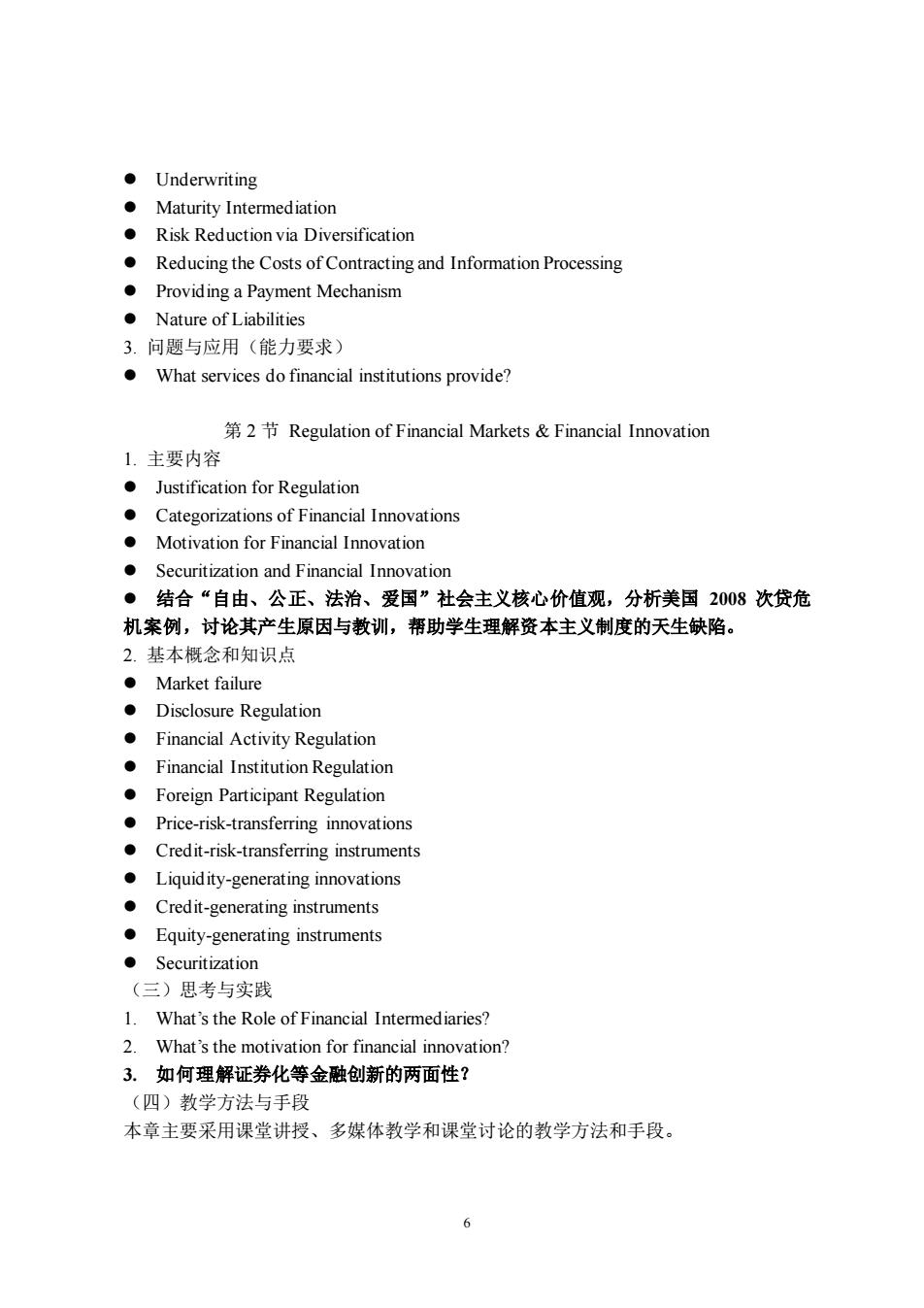
●Underwriting Maturity Intermediation Risk Reduction via Diversification Reducing the Costs of Contracting and Information Processing o Providing a payment Mechanism Nature of Liabilities 3.问题与应用(能力要求) What services do financial institutions provide? 2 Regulation of Financial Markets Financial Innovation 1.主要内容 Justification for Regulation Categorizations of Financial Innovations Motivation for Financial Innovation Securitization and Financial Innovation ●结合“自由、公正、法治、爱国”社会主义核心价值观,分析美国2008次贷危 机案例,讨论其产生原因与教训,帮助学生理解资本主义制度的天生缺陷。 2.基本概念和知识点 ●Market failure Disclosure Regulation Financial Activity Regulation Financial Institution Regulation Foreign Participant Regulation Price-risk-transferring innovations Credit-risk-transferring instruments Liquidity-generating innovations Credit-generating instruments Equity-generating instruments ●Securitization (三)思考与实践 1.What's the Role of Financial Intermediaries? 2.What's the motivation for financial innovation? 3.如何理解证券化等金融创新的两面性? (四)教学方法与手段 本章主要采用课堂讲授、多媒体教学和课堂讨论的教学方法和手段。 6
6 ⚫ Underwriting ⚫ Maturity Intermediation ⚫ Risk Reduction via Diversification ⚫ Reducing the Costs of Contracting and Information Processing ⚫ Providing a Payment Mechanism ⚫ Nature of Liabilities 3. 问题与应用(能力要求) ⚫ What services do financial institutions provide? 第 2 节 Regulation of Financial Markets & Financial Innovation 1. 主要内容 ⚫ Justification for Regulation ⚫ Categorizations of Financial Innovations ⚫ Motivation for Financial Innovation ⚫ Securitization and Financial Innovation ⚫ 结合“自由、公正、法治、爱国”社会主义核心价值观,分析美国 2008 次贷危 机案例,讨论其产生原因与教训,帮助学生理解资本主义制度的天生缺陷。 2. 基本概念和知识点 ⚫ Market failure ⚫ Disclosure Regulation ⚫ Financial Activity Regulation ⚫ Financial Institution Regulation ⚫ Foreign Participant Regulation ⚫ Price-risk-transferring innovations ⚫ Credit-risk-transferring instruments ⚫ Liquidity-generating innovations ⚫ Credit-generating instruments ⚫ Equity-generating instruments ⚫ Securitization (三)思考与实践 1. What’s the Role of Financial Intermediaries? 2. What’s the motivation for financial innovation? 3. 如何理解证券化等金融创新的两面性? (四)教学方法与手段 本章主要采用课堂讲授、多媒体教学和课堂讨论的教学方法和手段
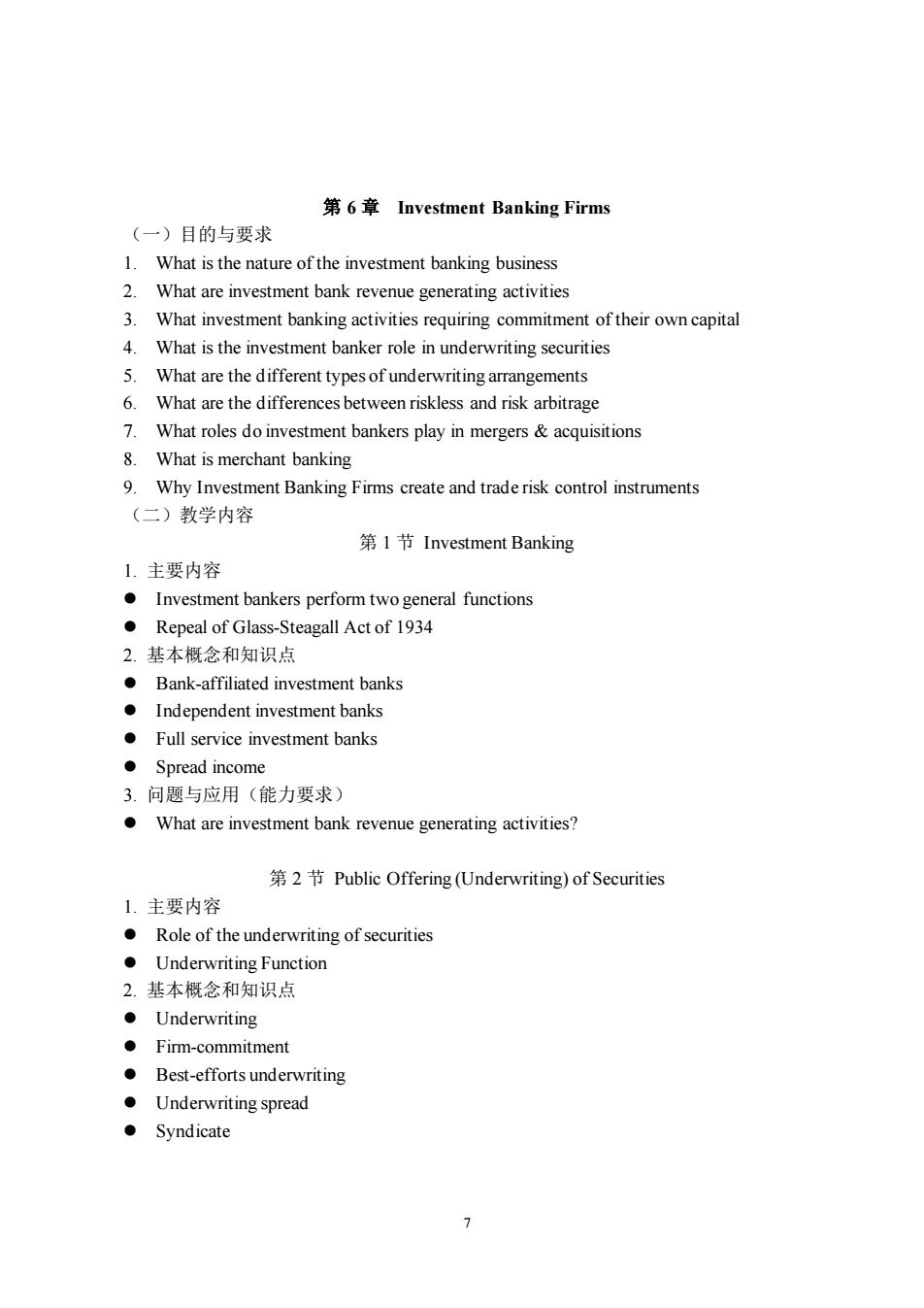
第6章Investment Banking Firms (一)目的与要求 1.What is the nature of the investment banking business 2.What are investment bank revenue generating activities 3.What investment banking activities requiring commitment of their own capital 4.What is the investment banker role in underwriting securities 5.What are the different types of underwriting arrangements 6. What are the differences between riskless and risk arbitrage 1. What roles do investment bankers play in mergers acquisitions 8.What is merchant banking 9.Why Investment Banking Firms create and trade risk control instruments (二)教学内容 第I节Investment Banking 1.主要内容 Investment bankers perform two general functions Repeal of Glass-Steagall Act of 1934 2基本概念和知识点 Bank-affiliated investment bank: Independent investment banks Full service investment banks ●Spread income 3.问题与应用(能力要求) What are investment bank revenue generating activities? 2Public Offering(Underwriting)of Securities 1.主要内容 Role of the underwriting of securities .Underwriting Function 2.基本概念和知识点 ●Underwriting ●Fimm-commitment o Best-efforts underwriting ●Underwriting spread ●Syndicate
7 第 6 章 Investment Banking Firms (一)目的与要求 1. What is the nature of the investment banking business 2. What are investment bank revenue generating activities 3. What investment banking activities requiring commitment of their own capital 4. What is the investment banker role in underwriting securities 5. What are the different types of underwriting arrangements 6. What are the differences between riskless and risk arbitrage 7. What roles do investment bankers play in mergers & acquisitions 8. What is merchant banking 9. Why Investment Banking Firms create and trade risk control instruments (二)教学内容 第 1 节 Investment Banking 1. 主要内容 ⚫ Investment bankers perform two general functions ⚫ Repeal of Glass-Steagall Act of 1934 2. 基本概念和知识点 ⚫ Bank-affiliated investment banks ⚫ Independent investment banks ⚫ Full service investment banks ⚫ Spread income 3. 问题与应用(能力要求) ⚫ What are investment bank revenue generating activities? 第 2 节 Public Offering (Underwriting) of Securities 1. 主要内容 ⚫ Role of the underwriting of securities ⚫ Underwriting Function 2. 基本概念和知识点 ⚫ Underwriting ⚫ Firm-commitment ⚫ Best-efforts underwriting ⚫ Underwriting spread ⚫ Syndicate
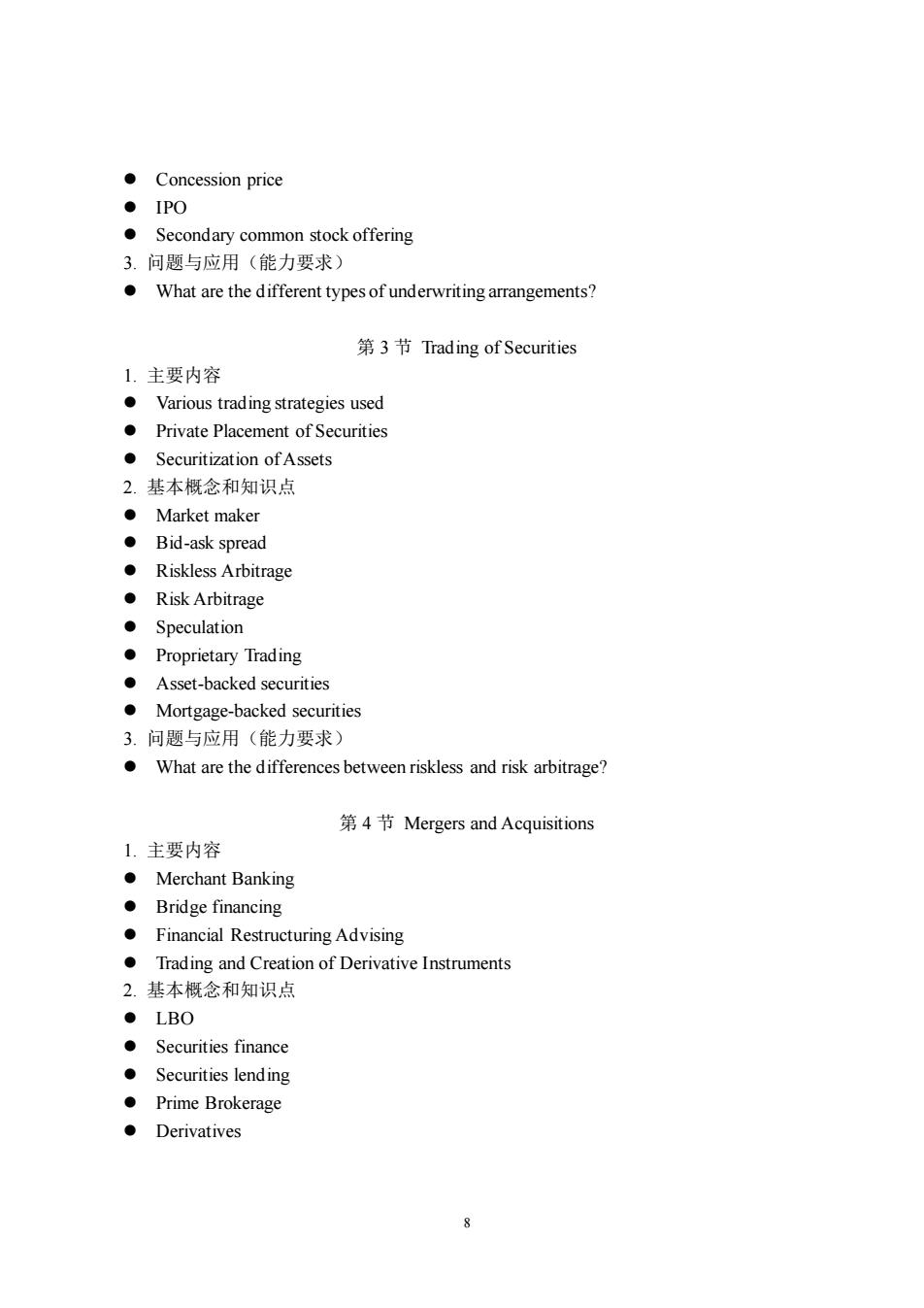
●Concession price ●IPO Secondary common stock offering 3.问题与应用(能力要求) o What are the different types of underwriting arrangements? 第3节Trading of Securities 1.主要内容 Various trading strategies used Private Placement of Securities Securitization ofAssets 2.基本概念和知识点 ●Market maker ● Bid-ask spread ●Riskless Arbitrage ●Risk Arbitrage ●Speculation ●Proprietary Trading Asset-backed securities Mortgage-backed securities 3.问题与应用(能力要求) What are the differences between riskless and risk arbitrage? 第4节Mergers and Acquisitions 1.主要内容 ●Merchant Banking ·Bridge financing Financial Restructuring Advising Trading and Creation of Derivative Instruments 2.基本概念和知识点 LBO ●Securities finance ● Securities lend ing ●Prime Brokerage ●Derivatives
8 ⚫ Concession price ⚫ IPO ⚫ Secondary common stock offering 3. 问题与应用(能力要求) ⚫ What are the different types of underwriting arrangements? 第 3 节 Trading of Securities 1. 主要内容 ⚫ Various trading strategies used ⚫ Private Placement of Securities ⚫ Securitization of Assets 2. 基本概念和知识点 ⚫ Market maker ⚫ Bid-ask spread ⚫ Riskless Arbitrage ⚫ Risk Arbitrage ⚫ Speculation ⚫ Proprietary Trading ⚫ Asset-backed securities ⚫ Mortgage-backed securities 3. 问题与应用(能力要求) ⚫ What are the differences between riskless and risk arbitrage? 第 4 节 Mergers and Acquisitions 1. 主要内容 ⚫ Merchant Banking ⚫ Bridge financing ⚫ Financial Restructuring Advising ⚫ Trading and Creation of Derivative Instruments 2. 基本概念和知识点 ⚫ LBO ⚫ Securities finance ⚫ Securities lending ⚫ Prime Brokerage ⚫ Derivatives
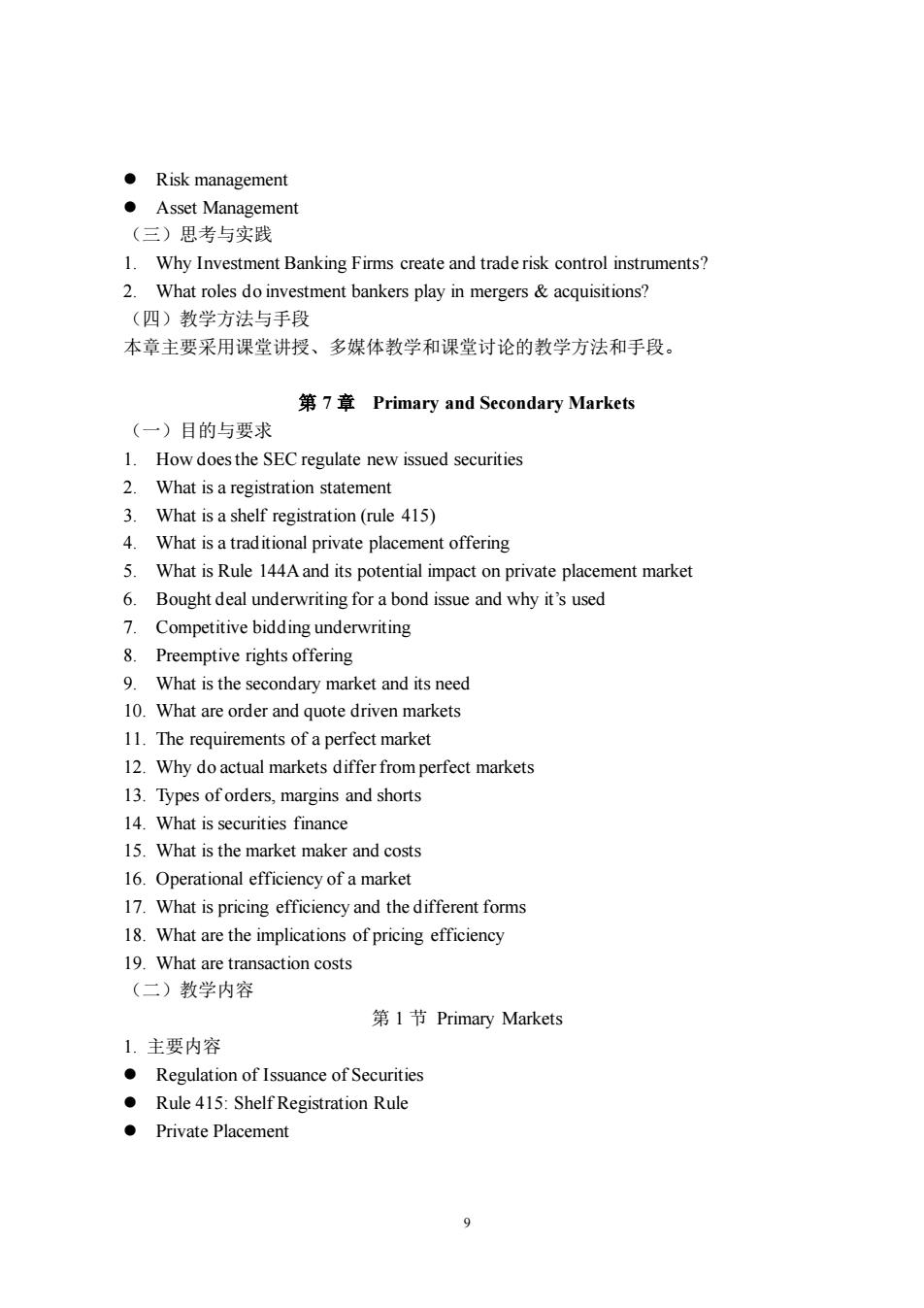
●Risk management ●Asset Management (三)思考与实践 1.Why Investment Banking Firms create and trade risk control instruments? 2.What roles do investment bankers play in mergers acquisitions? (四)教学方法与手段 本章主要采用课堂讲授、多媒体教学和课堂讨论的教学方法和手段。 第7章Primary and Secondary Markets (一)目的与要求 1.How doesthe SEC regulate new issued securities 2.What is a registration statement 3.What is a shelf registration(rule 415) 4.What is a traditional private placement offering 5.What is Rule 144A and its potential impact on private placement market 6.Bought deal underwriting for a bond issue and why it's used 7.Competitive bidding underwriting 8.Preemptive rights offering 9.What is the secondary market and its need 10.What are order and quote driven markets 11.The requirements of a perfect market 12.Why do actual markets differ from perfect markets 13.Types oforders,margins and shorts 14 What is securities finance 15.What is the market maker and costs 16.Operational efficiency of a market 17.What is pricing efficiency and the different forms 18.What are the implications of pricing efficiency 19.What are transaction costs (二)教学内容 第1节Primary Markets 1.主要内容 o Regulation of Issuance of Securities Rule 415:Shelf Registration Rule ●Private Placement
9 ⚫ Risk management ⚫ Asset Management (三)思考与实践 1. Why Investment Banking Firms create and trade risk control instruments? 2. What roles do investment bankers play in mergers & acquisitions? (四)教学方法与手段 本章主要采用课堂讲授、多媒体教学和课堂讨论的教学方法和手段。 第 7 章 Primary and Secondary Markets (一)目的与要求 1. How does the SEC regulate new issued securities 2. What is a registration statement 3. What is a shelf registration (rule 415) 4. What is a traditional private placement offering 5. What is Rule 144A and its potential impact on private placement market 6. Bought deal underwriting for a bond issue and why it’s used 7. Competitive bidding underwriting 8. Preemptive rights offering 9. What is the secondary market and its need 10. What are order and quote driven markets 11. The requirements of a perfect market 12. Why do actual markets differ from perfect markets 13. Types of orders, margins and shorts 14. What is securities finance 15. What is the market maker and costs 16. Operational efficiency of a market 17. What is pricing efficiency and the different forms 18. What are the implications of pricing efficiency 19. What are transaction costs (二)教学内容 第 1 节 Primary Markets 1. 主要内容 ⚫ Regulation of Issuance of Securities ⚫ Rule 415: Shelf Registration Rule ⚫ Private Placement
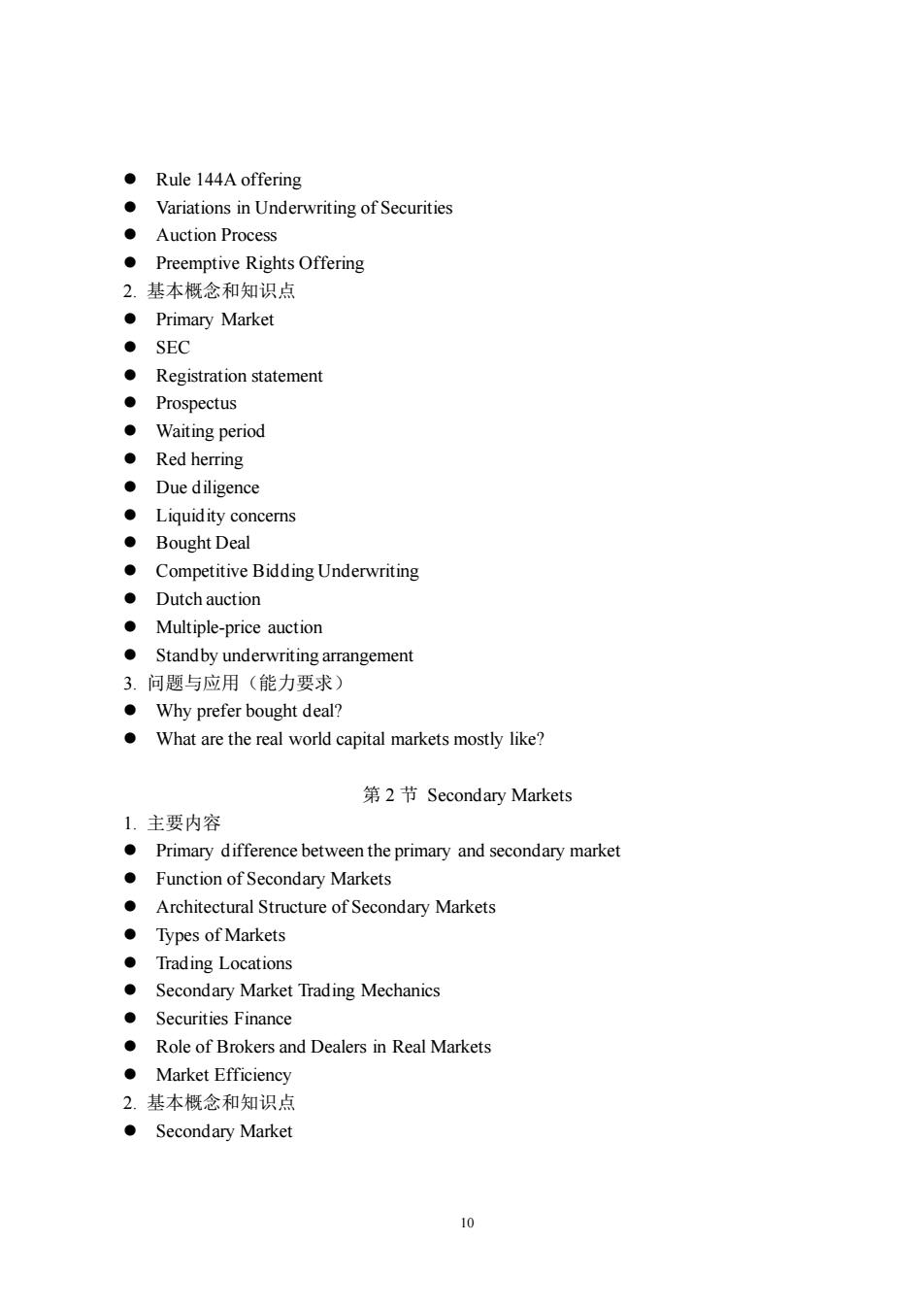
●Rule144 A offering Variations in Underwriting of Securities ●Auction Process Preemptive Rights Offering 2.基本概念和知识点 ●Primary Market ●SEC Registration statement ●Prospectus ●Waiting period ●Red herring ●Due diligence ●Liquidity concerns ●Bought Deal Competitive Bidding Underwriting ●Dutch auction Multiple-price auction Standby underwriting arrangement 3.问题与应用(能力要求) Why prefer bought deal? What are the real world capital markets mostly like? 第2节Secondary Markets 1.主要内容 Primary difference between the primary and secondary market Function of Secondary Markets Architectural Structure of Secondary Markets ·Types of Markets ●Trading Locations o Secondary Market Trading Mechanics ●Securities Finance Role of Brokers and Dealers in Real Markets ●Market Efficiency 2.基本概念和知识点 ● Secondary Market 10
10 ⚫ Rule 144A offering ⚫ Variations in Underwriting of Securities ⚫ Auction Process ⚫ Preemptive Rights Offering 2. 基本概念和知识点 ⚫ Primary Market ⚫ SEC ⚫ Registration statement ⚫ Prospectus ⚫ Waiting period ⚫ Red herring ⚫ Due diligence ⚫ Liquidity concerns ⚫ Bought Deal ⚫ Competitive Bidding Underwriting ⚫ Dutch auction ⚫ Multiple-price auction ⚫ Standby underwriting arrangement 3. 问题与应用(能力要求) ⚫ Why prefer bought deal? ⚫ What are the real world capital markets mostly like? 第 2 节 Secondary Markets 1. 主要内容 ⚫ Primary difference between the primary and secondary market ⚫ Function of Secondary Markets ⚫ Architectural Structure of Secondary Markets ⚫ Types of Markets ⚫ Trading Locations ⚫ Secondary Market Trading Mechanics ⚫ Securities Finance ⚫ Role of Brokers and Dealers in Real Markets ⚫ Market Efficiency 2. 基本概念和知识点 ⚫ Secondary Market